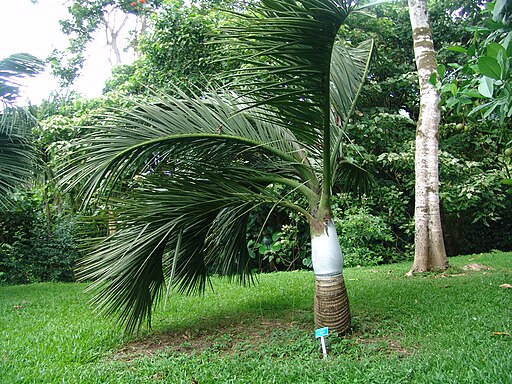Classification System: APG IV
Superregnum: Eukaryota
Regnum: Plantae
Cladus: Angiosperms
Cladus: Monocots
Cladus: Commelinids
Ordo: Arecales
Familia: Arecaceae
Subfamilia: Arecoideae
Tribus: Areceae
Subtribus: Dypsidinae
Genus: Dypsis
Species: Dypsis decipiens
Name
Dypsis decipiens (Becc.) Beentje & J.Dransf., 1995
Synonyms
Basionym
Chrysalidocarpus decipiens Becc., Beibl. Bot. Jahrb. Syst. 87: 36 (1906).
Homotypic
Macrophloga decipiens (Becc.) Becc., Palme Madagascar: 47 (1914).
Distribution
Native distribution areas:
Continental: Africa
Regional:Western Indian Ocean
C. Madagascar
References: Brummitt, R.K. 2001. TDWG – World Geographical Scheme for Recording Plant Distributions, 2nd Edition
References
Beentje, H.J. & Dransfield, J. 1995. The Palms of Madagascar 191.
Links
Govaerts, R. et al. 2019. Dypsis decipiens in Kew Science Plants of the World online. The Board of Trustees of the Royal Botanic Gardens, Kew. Published online. Accessed: 2019 Jun 06. Reference page.
International Plant Names Index. 2019. Dypsis decipiens. Published online. Accessed: Jun 06 2019.
The Plant List 2013. Dypsis decipiens in The Plant List Version 1.1. Published online. Accessed: 2019 Jun 06.
Tropicos.org 2019. Dypsis decipiens. Missouri Botanical Garden. Published online. Accessed: 06 Jun 2019.
USDA, ARS, Germplasm Resources Information Network. Dypsis decipiens in the Germplasm Resources Information Network (GRIN), U.S. Department of Agriculture Agricultural Research Service. Accessed: 08-Apr-12.
IUCN: Dypsis decipiens (Becc.) Beentje & J.Dransf. (Endangered)
Vernacular names
English: Manambe Palm
Dypsis decipiens, the Manambe palm, is a species of flowering plant in the Palm family (Arecaceae).[3] It is found only in the central highlands of Madagascar, between Fianarantsoa and Andilamena at 1,200 to 1,700 meters elevation. The species is threatened by habitat loss, increasing frequency of fires, and over-exploitation of its seeds for the horticultural trade.[1] Its most unique characteristic is that it commonly produces twin trunks like the letter "V", each trunk being up to 65 feet (20 meters) in height and up to 28 inches (70 centimeters) DBH (diameter at breast height).[4] There can also be three trunks, or a single trunk.
References
Rakotoarinivo, M.; Dransfield, J. (2012). "Dypsis decipiens". IUCN Red List of Threatened Species. 2012: e.T38532A2873559. doi:10.2305/IUCN.UK.2012.RLTS.T38532A2873559.en. Retrieved 16 November 2021.
"Appendices | CITES". cites.org. Retrieved 2022-01-14.
"Dypsis decipiens (Becc.) Beentje & J.Dransf". Plants of the World Online. The Trustees of the Royal Botanic Gardens, Kew. n.d. Retrieved August 21, 2020.
Dransfield, John; Beentje, Henk (1995). Palms of Madagascar. <not recorded>: International Palm Society. pp. 190–191.
Retrieved from "http://en.wikipedia.org/"
All text is available under the terms of the GNU Free Documentation License


